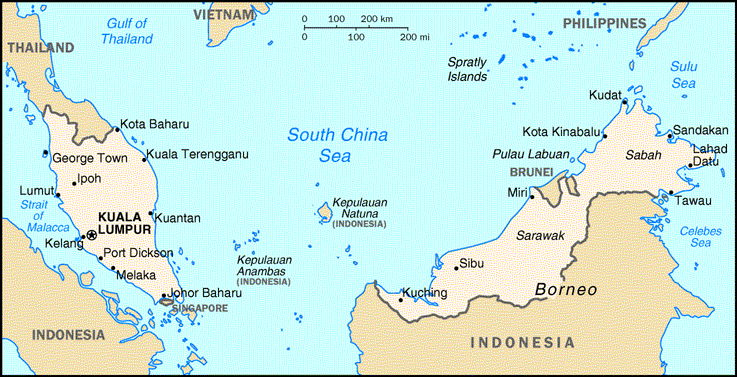Malaysia

Part 1 - Penninsular Malaysia
Febuary 11-20
NORTH FROM 1
When we landed in Sinagapore, we were at 1 degree North Latitude. Since leaving Singapore, we have been heading steadily North. Currently we sit on the small island on Pinang, located in the NorthWest corner of Peninsular Malaysia. On Friday the 11th, we boarded the local bus, and for $1.10 we headed across the Johor Strait into Malaysia. At the start of the bridge we jumped off our bus (local #170) and ran into to be stamped out of Singapore. The line for locals was huge, but the tourist line was empty. We raced through, and jumped on the next #170 for the ride across the bridge. We were feeling fast as we ran into Malaysian customs, and were abruptly slowed down by one pen and 4 pages of questions (each). Every single person that we had passed earlier, very slowly went through ahead of us. When we got through, we had missed probably 4 more buses, but caught one after only a slow wait. When we were dropped off, we bought ourselves bus passes to the Old Dutch settlement of Melacca where we spent our first night.
On the ride north, Mari and I began to learn a little of the Malay language, and we have been playing cribbage completely in Malaysian (if you can't say the numbers, you don't get the points), but at first we didn't have any language skill at all. When our bus stopped and I wanted a bag of chips, I just smiled and hoped for the best. I presented a bag of chips to the lady, who calmly replied "Satu Tiga Pullah". With a big stupid grin on my face I reached in my pocket and held out a palm full of change, from which she extracted $1.30. No Problems eh.
Travel in Malaysia is actually very staighforward, and almost everyone has a cursory grasp of English. And when they don't, most items can be pointed too. We have had several interesting meals just by walking up to a cook and saying dua tolong (two please). Mari drew the line today when I asked for Mee ayam (chicken and noodles), and the man lifted the lid on a big pot to display hundreds of chicken feet in a yellow stew mixture. We decided to go for the vegetarian option instead.
Another convenience that the Malay have added for the English tourist is a system of bilingual signs. This helps those who cannot read the local dialect find what they need to get around. Some classic examples are:
BAS EKSPRES (express bus)
TEKSI (taxi)
TREN (train)
Of course anything else that cannot be figured out phonetically is left to your imagination.
We spent two days exploring the colonial relics of Melacca, and puchasing new clothes (believe me, this was necessary) before buying a bus ticket ot Kuala Lumpur (the capital). We had bought our tickets an hour before leaving, and had gone to purchase some food. When we came back, a man rushed up to me.
"Come here, Come here" he shouted
I approached him, and he took my bus tickets, then gave me two new ones for one of the competitor buses.
When I looked at him strangely, I guess he felt obliged to explain.
"You no can take this bus" he said
"Why not" was my witty reply
"The tire" he explained with large hand gestures "it go BOOOM"
"Yeah, that can be a problem" and chuckiling I got on the other bus.
The capital was neat, but similar to any big city it was crowded, dirty, and polluted. We only stayed for a couple days. While there we decided to track down the national mosque and do some exploring. We found a huge old building, with beautiful minerettes atop. It was stunningly beautiful, but unfortunately it was only the train station, and the national mosque was grey square and imposing. Mari felt it looked similar to the math building from Waterloo University. We went in for a visit anyhow.
In a mosque, long pants must be worn for the men, and the women must wear a head covering and long flowing clothes. All footwear must be removed. Upon entry, Mari was covered up. She had a scarf over her head and a blue gown (similar to graduation gowns)over her body. I, wearing shorts, also had to wear a gown. We made quite a cute couple, and the muslim men got a good laugh out of me wearing the same outfit as Mari.
For a few days of comfort, we headed into the cameroon highlands. This region is a hilly section of interior Malaysia that has many hiking trails through pristine rainforest, and several tea plantations. Imported workers from Indonesia and Bangladesh work in the tea fields, for eight hours a day for the equivalent of about Eight dollars Canadian.
Tommorrow, we head into southern Thailand. We will be travelling in Malaysia again on the way to Singapore, and again in Eastern Malaysia (Sarawak and Sabah) in the upcoming months, so look for part two later on.